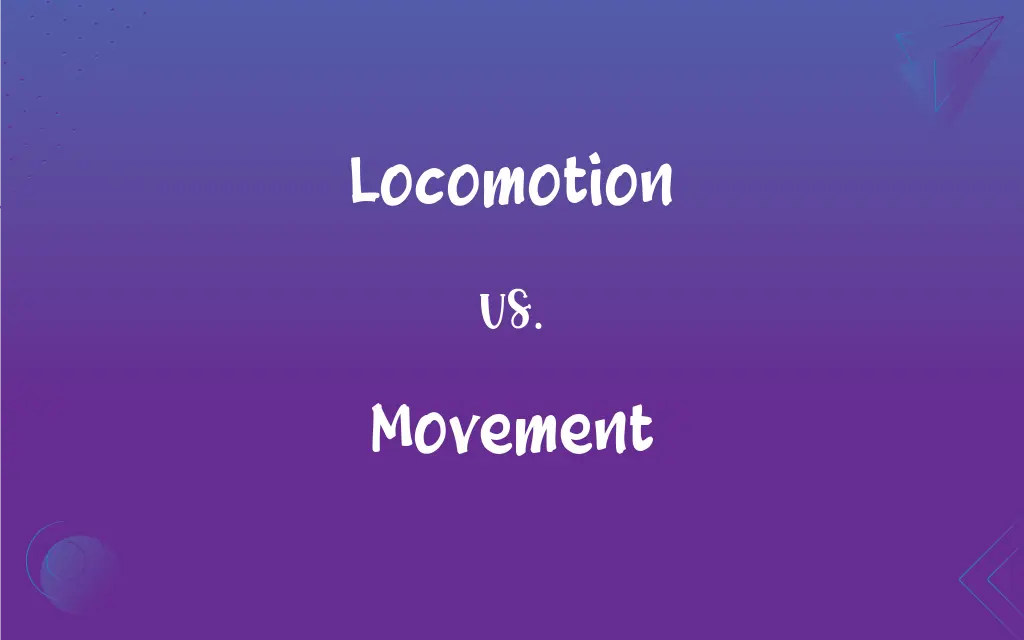Locomotion vs. Movement: What's the Difference?
Edited by Aimie Carlson || By Harlon Moss || Updated on October 27, 2023
Locomotion refers to an organism's ability to move from one place to another, while movement encompasses any change in position or place, whether of a whole organism or just a part of it.

Key Differences
Locomotion and movement are terms that describe different aspects of motion. At a glance, they might seem synonymous, but there are nuances in their meanings that set them apart.
Locomotion specifically deals with the ability of an organism to self-propel and travel from one location to another. This means it's about the holistic motion of an entity, primarily concerning displacement.
In contrast, movement is a broader term that covers any change in position or place. This can pertain to the entire organism, like when a person walks, or just a part, like the blinking of an eye or the beating of a heart.
While all locomotion is movement, not all movement is locomotion. For instance, the rotation of the Earth is a movement, but it's not locomotion since the Earth isn't an organism displacing itself.
It's crucial to understand the context in which the terms are used. In biology, locomotion often refers to the varied ways animals move, while movement can describe cellular or molecular actions.
ADVERTISEMENT
Comparison Chart
Definition
Movement from one place to another
Change in position or place
Scope
Specific to whole organisms
Can apply to both whole organisms and their parts
Application
Traveling or migrating
Any form of motion, including physiological processes
Example
Birds flying south for winter
The opening of a flower in response to sunlight
Contextual Use
Often used in animal behavior and ecology studies
Used broadly across many fields, including physics
ADVERTISEMENT
Locomotion and Movement Definitions
Locomotion
The act of traveling from one place to another.
Fish use fins for locomotion in water.
Movement
A shift or change in a particular direction.
The movement of the stock market is unpredictable.
Locomotion
The movement involving change in location.
The locomotion of birds varies from species to species.
Movement
A change in position or place.
The movement of the hands of a clock is continuous.
Locomotion
Self-propelled motion of an organism.
The locomotion of a cheetah is both powerful and swift.
Movement
The process by which objects or organisms undergo motion.
The graceful movement of dancers is captivating to watch.
Locomotion
The mechanism by which animals move around.
Bipedal locomotion distinguishes humans from most other primates.
Movement
An act of shifting from one point to another.
The sudden movement of the cat startled the mouse.
Locomotion
The capability of an entity to traverse its environment.
The study of insects offers insight into diverse forms of locomotion.
Movement
The dynamics or motion of a system.
The movement of planets is studied in astronomy.
Locomotion
The act of moving from place to place.
Movement
The act or an instance of moving; a change in place or position.
FAQs
Can plants exhibit locomotion?
Generally, plants don't exhibit locomotion, but they do show movement, like the turning of leaves towards light.
What kind of movement isn't locomotion?
Movements like the beating of a heart or the contraction of a muscle are not locomotion.
Are the terms locomotion and movement interchangeable?
While related, they aren't always interchangeable due to the specific nature of locomotion.
What's a societal movement?
A societal movement refers to a collective effort by people to promote change, not a physical motion.
Is every movement considered locomotion?
No, while all locomotion is movement, not all movement is locomotion.
Are there diseases that affect locomotion in humans?
Yes, diseases like Parkinson's can impact human locomotion.
Can a thought be considered a movement?
Not in the physical sense, but "movement" can metaphorically describe shifts in thought or opinion.
Do plants have movement?
Yes, plants can show movements, like phototropism or opening and closing of flowers.
What determines the mode of locomotion in animals?
Factors include anatomy, environment, and evolutionary adaptations.
Do machines have locomotion?
Machines can mimic locomotion, like cars moving or robots walking.
What studies locomotion in animals?
Ethology and biomechanics often study animal locomotion.
Is swimming a form of locomotion?
Yes, fish and other aquatic animals use swimming as a form of locomotion.
How is movement studied in physics?
Movement in physics is studied using concepts like velocity, acceleration, and force.
Can technology enhance human locomotion?
Yes, with tools like exoskeletons or prosthetics, technology can aid human locomotion.
What's the significance of studying animal locomotion?
It aids in understanding behaviors, evolutionary traits, and biomechanics.
Is the flight of a bird an example of locomotion?
Yes, a bird flying is an example of locomotion.
Does movement always require energy?
In biological contexts, most movement requires energy, but not all movement in physics does.
How do snakes exhibit locomotion?
Snakes use various methods like slithering and sidewinding for locomotion.
Can microscopic organisms exhibit locomotion?
Yes, many microorganisms, like bacteria, use flagella for locomotion.
Is the Earth's rotation a movement?
Yes, the Earth's rotation is a movement but not locomotion.
About Author
Written by
Harlon MossHarlon is a seasoned quality moderator and accomplished content writer for Difference Wiki. An alumnus of the prestigious University of California, he earned his degree in Computer Science. Leveraging his academic background, Harlon brings a meticulous and informed perspective to his work, ensuring content accuracy and excellence.
Edited by
Aimie CarlsonAimie Carlson, holding a master's degree in English literature, is a fervent English language enthusiast. She lends her writing talents to Difference Wiki, a prominent website that specializes in comparisons, offering readers insightful analyses that both captivate and inform.































































